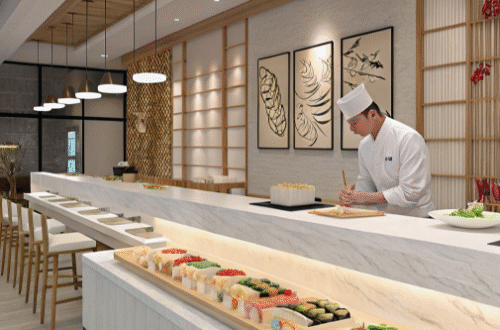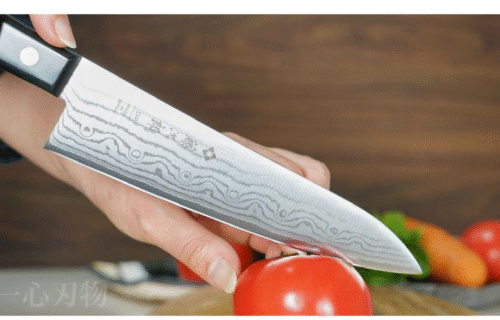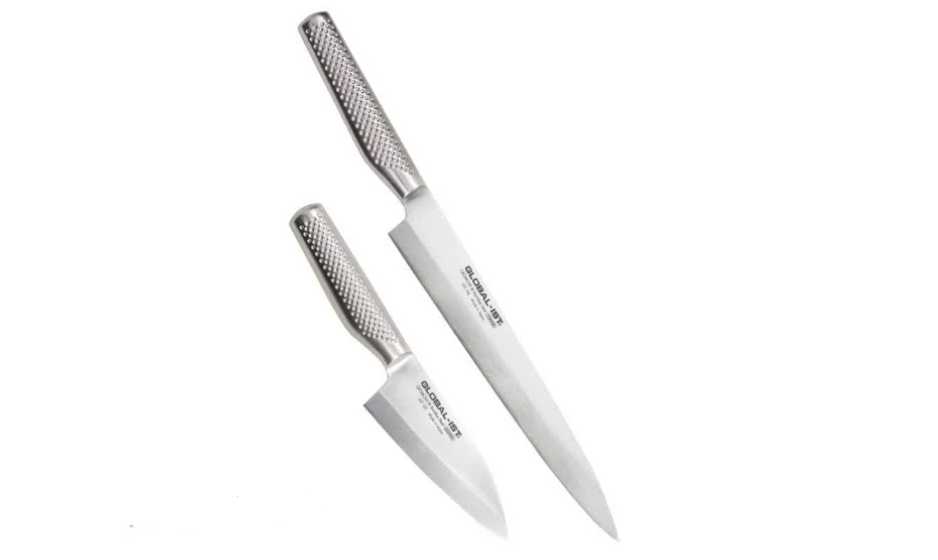
05-01-2. Mastering the Cut: Essential Types of Wabocho & Their Uses
In the previous chapter, we introduced how Japanese knives have developed uniquely within the traditions of Japanese sword smithing and the evolution of food culture. The essence of Japanese knives lies in their diverse types and the specialized functionality tailored to the specific purposes of each knife. The delicacy and beauty of Japanese cuisine are maximized through the proper use of the appropriate knives.
In this chapter, we will focus on the main types of Japanese knives most commonly used in the world of Japanese cuisine, delving deeply into the purposes and methods of use for each knife. By understanding the “philosophy of cutting” inherent in each Japanese knife—beyond the mere act of “cutting“—your understanding of Japanese cuisine will deepen significantly, and your culinary skills will improve. Let us guide you into the precise world of cutting crafted by Japanese knives.
2.1 Yanagiba: Precision Slicing for Sashimi & Sushi
In Japanese food culture, sashimi and sushi captivate people around the world with their artistic beauty and delicate flavors. One of the most important factors that determines the quality of these two dishes is the “cut” of the fish. And the Yanagiba Bocho is essential for maintaining that cut in perfect condition.
The Birth and Development of Yanagiba: A Child of Sashimi Culture
Yanagiba knives developed alongside the blossoming of sashimi culture during the Edo period. Although knives for cutting fish existed prior to this, the yanagiba knife evolved uniquely as a knife specialized for beautifully and deliciously serving raw fish. It is said that the name “yanagiba” was given because its long, thin blade resembles the leaves of a willow tree.
Sashimi is a simple dish consisting of thinly sliced fish, but precisely because of its simplicity, the freshness of the ingredients and the skill of the slicing technique directly influence both the taste and appearance. The willow-blade knife was born as a result of pursuing the ultimate in sharpness to meet these demands.
Structure and Characteristics of Yanagiba: Why It’s Perfect for Sashimi
The most distinctive feature of Yanagiba knives is their long, thin, single-edged blades.
- Long blade length:
- Generally, the blade length is designed to be very long, ranging from 20 cm to 30 cm or more. This is to enable a single, uninterrupted cut, known as “hikigiri,” through the fish. By cutting in one smooth motion, damage to the fish’s cells is minimized, and the structure of the cross-section is preserved. This locks in the fish’s natural flavor and creates a beautiful luster on the cut surface. If the blade length is too short and the blade must be moved multiple times to cut, the cells of the food are destroyed, causing dripping (a liquid containing flavor components) to occur, which can compromise the taste and freshness of the food.
- Single Bevel Structure: Traditional Yanagi knives feature a single bevel, with only one side of the blade (usually the dominant hand side) sharpened to a razor edge. This single bevel structure enables remarkable sharpness and precise control.
- Sharpness:The tip of the single bevel blade can be sharpened to an extremely sharp angle, resulting in minimal resistance when cutting ingredients, allowing for smooth, butter-like cuts.
- Food penetration: The single-edged blade has a natural “guiding” effect that causes it to penetrate deep into the food as it cuts. This allows even soft foods like fish to be cut straight and thinly.
- Ura-oshi: The back of the single-edged knife (the unsharpened side) has a slight indentation called “ura-suki.” This Ura-suki prevents the cut ingredients from sticking to the blade and reduces resistance. Additionally, by creating a very slight sharpened surface along the edge of the Ura-suki called “Ura-oshi,” the overall strength of the blade is maintained, and the sharpness is sustained.
- Thin Blade Profile: The blade is extremely thin from the base to the tip. This further reduces resistance against ingredients, allowing for sharp cuts without crushing cells.
How to Use Yanagiba: The Essence of Hikigiri
The essence of the Yanagiba knife lies in its unique cutting technique called “hikigiri.” This involves using the entire blade, from tip to base, to cut ingredients in one swift motion while pulling toward you.
- 1. Grip: Hold the knife firmly in your dominant hand and place the base of the blade at the edge of the food you are cutting.
- 2. Beginning the cut: Gently press the base of the blade against the food, then pull it toward you while sliding the entire blade downward to make the cut. The key here is not to apply too much force, but to let the weight and sharpness of the knife do the work.
- 3. Cut all the way through: Use the entire blade, including the tip, to cut the ingredient in one smooth motion. It is important not to stop the blade midway or force it through.
This cutting technique results in a smooth, glossy surface on the fish, making it visually appealing and enhancing its texture. The difference between the sashimi served by sushi chefs and that cut at home lies largely in the sharpness of the willow-blade knife and the mastery of this cutting technique.
Importance of Maintenance: Preserving the Soul of Yanagiba
Yanagi knives require frequent maintenance and regular sharpening to maintain their sharpness. In particular, high-carbon steel Yanagi knives are prone to rust, so it is important to wash them immediately after use, wipe them completely dry, and store them in a dry place.
Sharpening is done using a medium-grit stone and a finishing stone, ensuring the blade angle and back bevel are maintained accurately. For professional chefs, the act of sharpening a knife is also a time for concentration and mental focus on cooking.
What Yanagiba Symbolizes
Yanagiba knives are not merely cooking tools. They symbolize the delicacy of Japanese food culture, respect for ingredients, and the spirit of exploration of craftsmen. The precision of these knives plays a significant role in the global popularity of sashimi and sushi. When visiting Japan, if you see a craftsman wielding a yanagiba knife at a sushi counter, take a moment to appreciate the history and skill embodied in that single blade.
2.2 Deba: The Powerhouse for Filleting Fish
Fish dishes are an essential part of Japanese cuisine. When it comes to cutting up a whole fish into fillets, the **Deba Bocho** knife is a powerful ally. Its thickness, weight, and sturdy construction are specialized for cutting through even the hardest fish bones, making it an indispensable tool for professional chefs who work with seafood.
Origin and Functionality of Deba Bocho
There are various theories about the origin of the name “deba” in deba knives, but one theory is that knives made in Sakai, Osaka, were named after their thick blades, which protruded more than other knives. Another name for this knife is “Funayuki knife,” which is said to have originated from its use by fishermen for cutting fish on boats. This suggests that the deba knife has evolved as a specialized tool for fish filleting.
Fish filleting involves not only cutting but also removing the head, gutting, breaking the bones, and slicing the flesh into three pieces. The deba knife combines versatility to handle all these processes with the strength required for the task.
Structure and Characteristics of Deba Bocho: Robustness and Functional Beauty
The deba knife stands out from other Japanese knives due to its appearance. It is equipped with a blade that is thicker than other Japanese knives.
- Thick and Heavy Blade:
- The most distinctive feature of a Deba knife is its heavy weight and thick blade. It is designed to effortlessly cut through the hard bones of fish. By utilizing the weight of the blade, you can efficiently cut through bones with minimal effort. The thickness of the blade base can reach up to nearly 10mm.
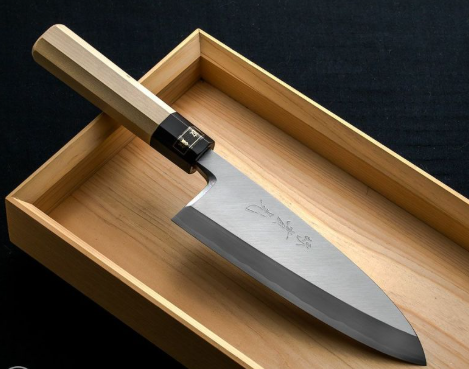
- Single Bevel Structure: Like Yanagi knives, traditional deba knives also have a single bevel. This single bevel structure enables precise control when cleanly removing fish flesh from bones. The front side (dominant hand side) of the blade is sharpened, while the back side has a full tang.
- Bone-cutting blade base: The area near the blade base is particularly thick and sturdy, making it suitable for cutting off fish heads or thick bones.
- Flesh-cutting blade tip: As the blade approaches the tip, it gradually becomes thinner and sharper. This allows for delicate tasks such as cleanly removing flesh from bones or peeling skin.
- Center of gravity balance (Balance Point): Due to the weight of the blade, the center of gravity is often positioned toward the blade base, which stabilizes the knife and enables precise cuts.
How to Use Deba Bocho: Mastering Fish
A deba knife can handle a wide range of tasks involved in filleting fish.
- 1. Removing the Head:
- Using the part of the blade closest to the handle, insert the blade deeply behind the gills of the fish and push down to cut through the bones. Utilizing the weight of the Deba knife will allow you to perform this task smoothly.
- 2. Gutting:
- Use the tip of the blade to open the abdomen and carefully remove the internal organs without damaging them.
- 3. Filleting into Three Pieces (Sanmai-oroshi):
- First, make a light incision along the fish’s backbone using the tip of the blade.
- Next, slide the blade along the bone to separate one side of the flesh. The key here is to maintain the proper angle of the blade and ensure no flesh remains on the bone.
- Repeat the process on the opposite side, and finally, scrape off the remaining flesh (naka-ochi) from the central bone.
- The thickness and weight of the deba knife provide stability when cutting the flesh cleanly along the bone.
- 4. Cutting Bones:
- Depending on the type of fish, it may be necessary to cut through thick bones. Use the sturdy base of the deba knife to strike and cut through the bone.
Maintenance and Sharpening Characteristics
Like the Yanagiba knife, the Deba knife is also single-edged, and proper sharpening is necessary to maintain its sharpness. In particular, because the blade is thick and used for cutting bones, it is prone to chipping. If the blade chips, start with a coarse whetstone, then move on to a medium whetstone, and finally a finishing whetstone. It is important to master the sharpening technique that takes advantage of the blade’s thickness. After use, be sure to clean it thoroughly and wipe off all moisture to prevent rust.
The deba knife is truly a “blade of life,” transforming living fish into delicious and safe ingredients. Its powerful sharpness is the culmination of craftsmen’s wisdom and technique, enabling us to fully enjoy the bountiful blessings of Japan’s rich seas.
Usuba: The Art of Vegetable Preparation & Decorative Cuts
When discussing the beauty of Japanese cuisine, it is essential to mention the delicate cutting of vegetables and the artistry of presentation that results from it. Supporting this aesthetic is the **Usuba Bocho**. As its name suggests, the Usuba Bocho has an extremely thin blade and is specialized for cutting vegetables thinly, accurately, and beautifully.
Roots of Usuba Bocho and the Aesthetics of Japanese Cuisine
The Usuba Bocho has been refined alongside the development of cuisines that emphasize the beauty of presentation, such as Kyoto cuisine (Kyo-ryori) and kaiseki cuisine (Kaiseki Ryori), which make extensive use of vegetables. In Japanese food culture, not only the taste of ingredients but also the visual appeal is highly valued. For example, techniques such as peeling daikon radish into thin strips, slicing vegetables into matchsticks, and intricate carving require the precise cutting ability of the usuba knife and the skilled techniques of the chef.
By cutting vegetables without damaging their fibers, the knife preserves the natural flavor and crisp texture of the ingredients while creating a beautiful cross-section. This is the ultimate goal that the usuba knife strives to achieve.
Structure and Characteristics of Usuba Bocho: Achieving Ultimate Thin Slicing
The most distinctive feature of a thin-bladed knife is its extremely thin blade and straight cutting edge.
- Extremely Thin Blade Profile:
- The blade is made very thin from the base to the tip. This minimizes resistance when cutting ingredients, allowing you to cut through even soft vegetables sharply without crushing them.
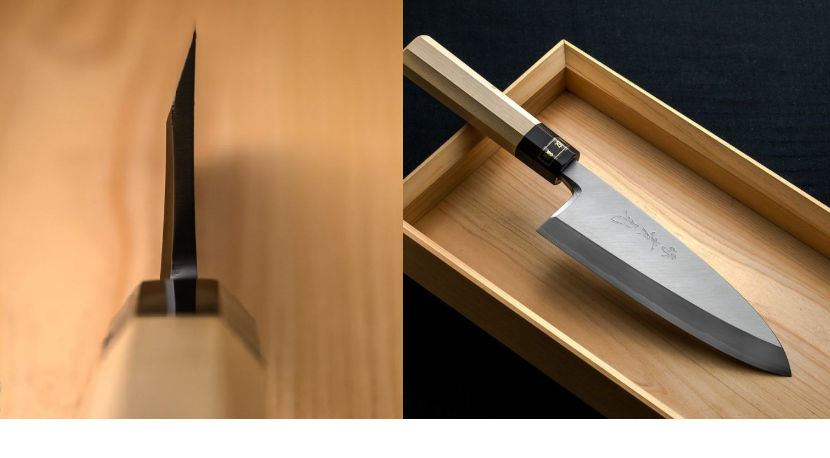
- Straight Blade Edge:
- The blade edge is designed to be almost straight, allowing the entire blade to contact the cutting board evenly and enabling you to slice thinly with uniform thickness. This is an essential feature for precise tasks such as peeling daikon radish or slicing it into thin strips.
- Single Bevel:
- Traditional thin-bladed knives, like willow-bladed and deba knives, have a single bevel. This single-bevel structure enables precise control when cutting delicate vegetables and facilitates thin slicing of ingredients. The front side of the blade is sharpened at a sharp angle, while the back side has a full tang.
- Shape Variations (Regional Variations):
- Kanto-style thin-bladed knife (Azuma-gata Usuba / Kanto Usuba): The blade tip is angular, and the overall shape is close to a rectangle. Similar to a vegetable-cutting knife, but thinner, with a sharper sharpening angle, making it suitable for delicate tasks.
- Kama-gata Usuba / Kansai Usuba: The blade tip is rounded like a sickle. Developed in the Kansai region, it is suitable for detailed work and decorative cutting using the blade tip.
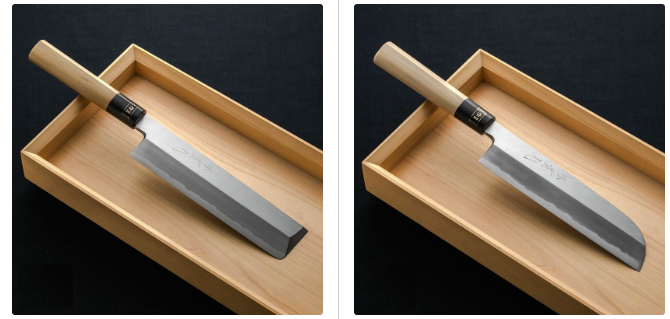
How to Use Usuba Bocho: The Art of Manipulating Vegetables
Thin-bladed knives are mainly used for “push cuts.” Place the entire blade on the cutting board and push forward from the front to the back to cut.
- 1. Katsura-muki:
- This is an advanced technique for peeling vegetables such as daikon radish into thin, long strips, as if peeling a wig. Place the base of the Usuba knife against the food and slide the entire blade to peel at a consistent thickness. This technique is where the true value of the Usuba knife shines.
- 2. Sengiri:
- A thin-bladed knife is also useful for cutting daikon radish and carrots into very thin strips. Uniformly thin strips not only look beautiful but also have a pleasant texture.
- 3. Decorative Cutting (Kazari-giri):
- A thin-bladed knife is also used for cutting vegetables into flower or leaf shapes or for intricate carving. This technique is essential for the delicate presentation of Japanese cuisine.
Maintenance and Sharpening Considerations
Due to their thinness, thin-bladed knives require careful attention to prevent chipping or bending of the blade tip. They must never be used on hard ingredients or frozen foods. Sharpening must be done carefully using a medium-grit stone and a finishing stone to avoid damaging the delicate blade. Sharpening the back bevel is also important. After use, wash immediately, thoroughly dry, and store in a safe place.
Thin-bladed knives are tools that infuse simple ingredients like vegetables with life and artistic flair. Their sharpness and precise control embody the delicate aesthetic sensibility and attention to detail that Japanese cuisine is renowned for.
Gyuto & Santoku: Your All-Purpose Japanese Kitchen Companions
The traditional Japanese knives introduced so far, such as the Yanagiba, Deba, and Usuba, are specialized knives designed for specific ingredients and cooking methods. However, in Japanese kitchens, there are also **”utility knives”** that have evolved under the influence of Western knives and can handle all kinds of ingredients, including meat, fish, and vegetables. These are the **Gyuto and Santoku Bocho**. These knives are widely used by professional chefs and home cooks alike, and are an excellent choice for those new to Japanese knives.
Gyuto: Fusion of Western Technique and Japanese Craftsmanship
The name “Gyuto” comes from the Western “Chef’s Knife,” which was originally introduced to Japan for cutting beef. After the Meiji era, as meat-eating culture spread in Japan, it was improved upon using Japanese blacksmithing techniques, giving birth to the uniquely Japanese Gyuto.
- Structure and Characteristics:
- Double Bevel:
- Most Gyuto knives have a double bevel, sharpened on both sides. This allows for straight cutting regardless of handedness.
- Versatile Shape:
- The blade length typically ranges from 18 cm to 27 cm, with a sharp tip, making it versatile for various tasks such as slicing meat, cutting fish fillets, and shredding vegetables. The base of the blade is suitable for cutting hard materials, while the tip is ideal for precise work.
- Thinness and sharpness:
- Compared to Western chef’s knives, Japanese Gyuto knives tend to be thinner and sharper. This reflects Japanese blacksmithing techniques and the philosophy of Japanese cuisine, which emphasizes delicate cuts of ingredients.
- Double Bevel:
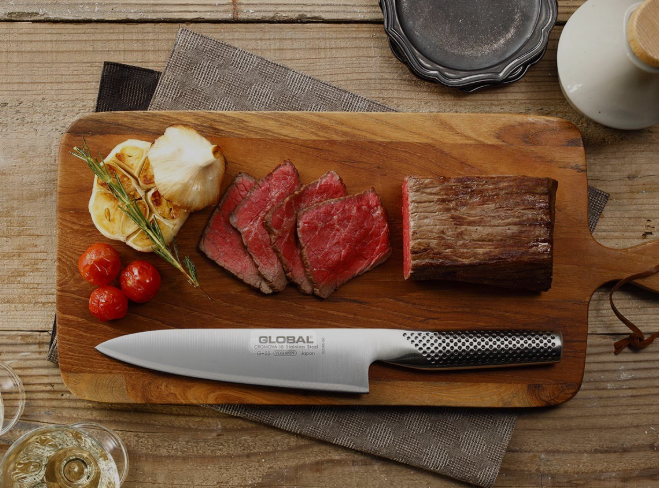
- Usage:
- Pushing and pulling cuts:
- When cutting meat, use a “pulling cut,” and when cutting vegetables, use a “pushing cut” or “sliding cut,” among other techniques, depending on the ingredient and purpose.
- Versatile Usage:
- In professional kitchens, it is used as a sub for a cleaver or a yanagiba knife, or as a versatile main knife. In home kitchens, it is extremely convenient as it can handle a wide range of cooking tasks with just one knife.
- Pushing and pulling cuts:
Santoku Bocho: The Ally of the Japanese Home Kitchen
The name “Santoku” is said to derive from the three ingredients “meat, fish, and vegetables” and their “merits” (advantages). It was developed as a Japanese-style utility knife, modified from a chef’s knife to suit the needs of Japanese households.
- Structure and Characteristics:
- Ideal for Japanese Kitchens: The blade length is typically around 16–18 cm, making it easy to handle in the narrow kitchens and on cutting boards common in Japan.
- Double-Edged Structure: Like a chef’s knife, it has a double-edged structure, making it easy for anyone to use.
- Distinctive Blade Tip: The blade tip is not as sharp as a chef’s knife but has a slightly rounded shape. This enhances stability and improves safety for everyday use in the home.
- Versatility: It can handle common household cooking tasks such as cutting meat, handling fish fillets, and chopping vegetables with just one knife.
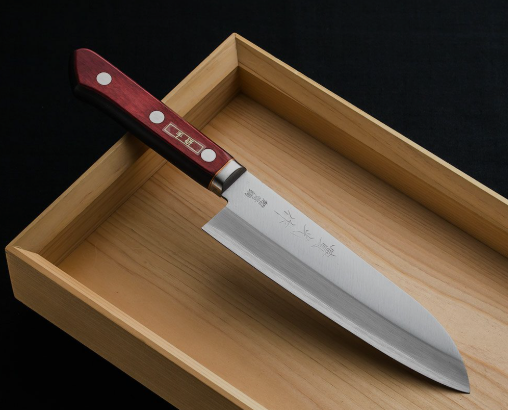
- Usage:
- Versatile Cooking: This single knife can handle most home cooking tasks. It allows for smooth execution of basic actions such as chopping, slicing, and dicing.
- Recommended for Beginners: It does not require special techniques and can be used relatively easily by anyone, making it strongly recommended for those purchasing a Japanese knife for the first time or for cooking beginners.
Choosing Between Gyuto and Santoku
The choice between the two primarily depends on personal preference and frequency of use.
- Gyuto is suitable for:
- Those who often handle large ingredients (such as a roast beef roast).
- Those who frequently cut meat or fish.
- Those who want to pursue serious cooking.
- Those who prefer a longer blade length.
- Santoku is suitable for:
- Those who primarily use it in a typical Japanese household.
- Those who prefer a knife that is easy to maneuver.
- Those who want an all-purpose knife for everyday cooking.
- Those purchasing a Japanese knife for the first time.
Common Maintenance for Both
Both the gyuto knife and the santoku knife are double-edged, making them relatively easier to sharpen compared to single-edged Japanese knives (yanagiba, deba, and usuba). You can restore their sharpness with a medium-grit whetstone and further sharpen them with a finishing whetstone. Since most are made of stainless steel, they are resistant to rust, but it is important to wash them thoroughly after use, dry them completely, and store them properly.
The gyuto and santoku knives are the perfect fusion of traditional Japanese blade craftsmanship and modern diverse dietary habits, making them the indispensable “versatile companions” of the Japanese kitchen. With just one of these knives, your daily cooking will become significantly more enjoyable and efficient.
2.5 Petty Knives: Small Blades, Big Precision for Delicate Tasks
In the kitchen, you need not only a large, powerful knife, but also a small companion that is maneuverable and capable of delicate work. That is the **petty knife**. Although its name may imply “petty” (small, insignificant), its functionality and importance are by no means insignificant. Rather, it demonstrates “great precision” that a large knife cannot achieve in detailed work.
Role and Versatility of Petty Knives
The petty knife is a Japanese development of the Western “petty knife.” It is mainly used for delicate tasks such as the following.
- Peeling fruits and vegetables: Ideal for thinly peeling apples, potatoes, citrus fruits, and other fruits and vegetables.
- Decorative and intricate cutting: Used to cut small fruits and vegetables into flower or leaf shapes, or to add intricate patterns.
- Removing tendons and preparing ingredients: Useful for carefully removing small tendons from meat and fish, or removing avocado pits.
- Final adjustments for plating: Convenient for shaping dishes or chopping herbs when plating food.
- Cutting small ingredients: Safer and more efficient than a large knife for handling small quantities of ingredients like minced garlic or ginger.
Structure and Characteristics of Petty Knives: Agile Design
The petty knife is characterized by its compact design, which is well-suited to its intended use.
- Short Blade Length: The blade length is typically very short, ranging from 12 cm to 15 cm. This makes it easy to perform detailed work close to the handle and allows for very smooth handling of the knife as a whole.
- Narrow Blade Profile: The blade is narrow and thin, reducing resistance when cutting ingredients and enabling precise cuts.
- Double Bevel: Most petty knives are double-beveled, allowing them to be used by both left- and right-handed individuals.
- Pointed Tip: The sharp, pointed tip is ideal for detailed work and tasks such as piercing ingredients.
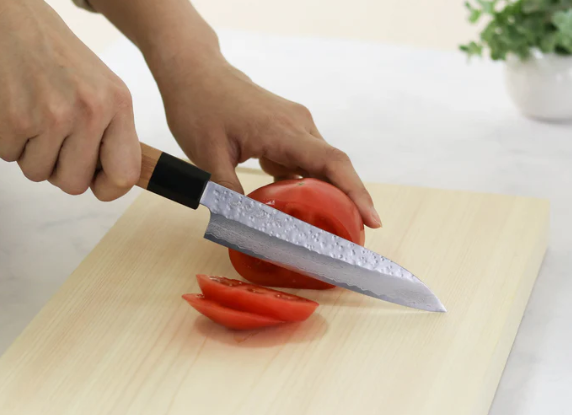
How to Use Petty Knives: Like an Extension of Your Fingers
A paring knife is like an extension of your fingertips, and it really shines when you need to do stuff that needs precise control.
- 1. Held in Hand: In addition to cutting ingredients placed on a cutting board, it is often used to process ingredients while held in the hand (air cutting). Tasks such as peeling and coring can be performed with intuitive movements.
- 2. Fine Movements: Utilizing subtle movements of the wrist and fingertips, the blade tip is used to make precise cuts or slice in curved patterns.
Maintenance and Storage
Like other knives, it is important to wash your petty knife immediately after use and wipe it completely dry. Because the blade is thin and narrow, care must be taken not to bump it against hard objects or drop it. Sharpening is done with a whetstone, as with other knives, but because the blade is small, it is necessary to maintain the angle carefully.
While the petty knife may often be overshadowed by the main kitchen knife, it is an indispensable tool in supporting the Japanese culinary principles of “attention to detail” and “aesthetic presentation.” Adding one to your kitchen will make daily cooking more enjoyable and result in a more professional finish.
Conclusion: The Right Knife for Every Masterful Cut
We have delved deeply into the main types of Japanese knives and their respective uses. The Yanagiba knife pursues the ultimate sharpness for sashimi, the Deba knife powerfully supports the dissection of fish, and the Usuba knife brings out the delicate beauty of vegetables. The Gyuto and Santoku knives bring versatility and convenience to daily cooking, while the Petit knife enables precision in detail.
Each Japanese knife is specialized for specific ingredients and cooking methods due to its unique shape, blade sharpening, and balance of center of gravity. This demonstrates how important the Japanese philosophy of “appropriate tools for appropriate tasks” is in the selection and use of tools. Choosing the right Japanese knife means more than just selecting a tool. It is about experiencing and inheriting the respect for ingredients, passion for cooking, and the wisdom and techniques cultivated over centuries in Japanese culinary culture.
We hope that these Japanese knives will serve not merely as “cutting tools” but as “partners” that enhance the quality of your cooking and deepen your understanding of Japanese culinary culture. By selecting the appropriate Japanese knife, your kitchen will transform into a true stage where the essence of Japanese cuisine can be fully realized.


